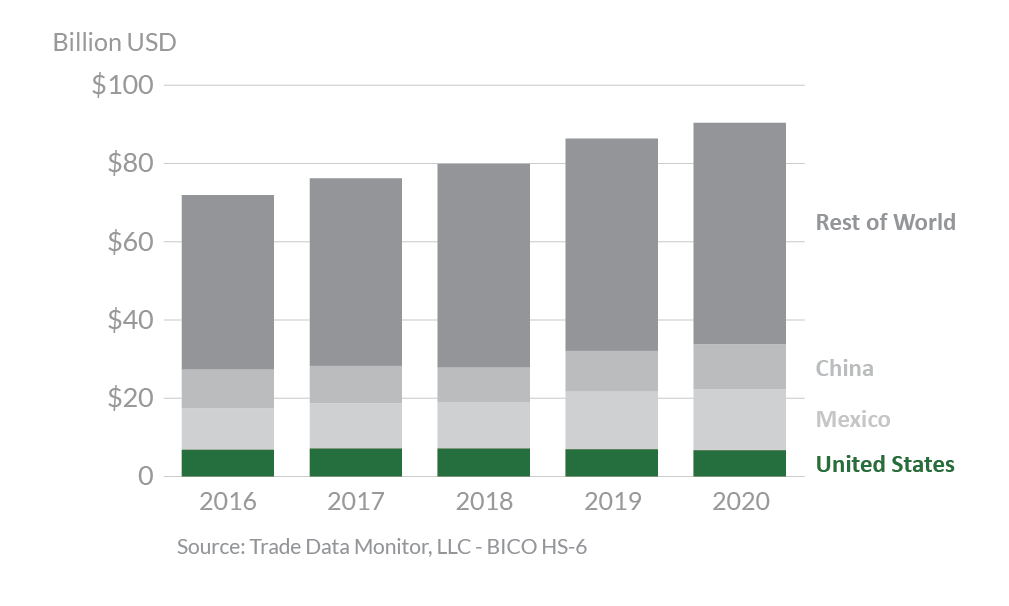
Fresh Fruits and Vegetables 2020 Export Highlights
Top 10 Export Markets for U.S. Fresh Fruits and Vegetables(values in million USD) |
|||||||
| Country | 2016 | 2017 | 2018 | 2019 | 2020 | 2019-2020 % Change | 2016-2020 Average |
| Canada | 3,440 | 3,487 | 3,487 | 3,471 | 3,471 | 0% | 3,471 |
| Mexico | 602 | 704 | 760 | 803 | 772 | -4% | 728 |
| South Korea | 401 | 508 | 512 | 419 | 480 | 15% | 464 |
| Japan | 481 | 413 | 427 | 401 | 373 | -7% | 419 |
| Taiwan | 317 | 292 | 278 | 323 | 263 | -19% | 295 |
| EU27+UK | 234 | 246 | 247 | 216 | 199 | -8% | 228 |
| Hong Kong | 292 | 302 | 248 | 205 | 190 | -7% | 247 |
| Vietnam | 67 | 72 | 103 | 140 | 138 | -1% | 104 |
| China | 188 | 226 | 177 | 119 | 112 | -6% | 164 |
| Australia | 117 | 118 | 118 | 112 | 104 | -7% | 114 |
| All Others | 869 | 896 | 965 | 848 | 788 | -7% | 873 |
| Total Exported | 7,010 | 7,265 | 7,252 | 7,056 | 6,889 | -2% | 7,094 |
Source: U.S. Census Bureau Trade Data - BICO HS-10
Highlights
In 2020, the value of U.S. fresh fruit and vegetable exports to the world reached $6.9 billion, a 2- percent decline from the prior year. Due to geographic proximity and climate, Canada remained the top U.S. market, accounting for 49 percent of total exports, or $3.5 billion. Mexico came in a distant second with 10 percent of U.S. exports while no other markets had more than 7 percent share of exports.
U.S. apple exports experienced the greatest drop, down $105 million from 2019 and accounting for more than half of the overall decline, with the largest losses in Taiwan, India, and Canada. U.S. orange exports had the largest growth, up $48 million on higher exports to South Korea and Canada. Fruit and vegetable exports to China declined for the third year in a row. However, South Korea saw a significant gain of $61 million. Apples, pears, peaches, citrus, table grapes, and cherries continue to make up nearly half of total U.S. fresh fruit and vegetable exports.
Drivers
- Top fresh fruit export commodities included apples, grapes, oranges, and cherries, which accounted for a combined $2.6 billion, with top markets including Canada, Mexico, Japan, South Korea, and Taiwan.
- Top fresh vegetable export commodities included lettuce, potatoes, sweet potatoes, onions, and cauliflower, which accounted for a combined $1.2 billion, with top markets including Canada, the EU27+UK, and Mexico.
- India imposed an additional 20 percent tariff on U.S. apples in June 2019, bringing the total tariff rate to 70 percent.
- Regulatory requirements, including pesticide maximum residue levels (MRLs) on U.S. fruits and vegetables that differ from those of the United States, continued to challenge exporters selling to the EU27+UK and South Korea. The United States continues to adopt science-based standards.
Global Fresh Fruit and Vegetable Exports

Looking Ahead
U.S. apple production is forecast to decline due to weather-damaged crops in Washington and Michigan. Reduced supplies are expected to pressure exports lower. U.S. table grape production is forecast up more than 100,000 tons to 1 million. Despite good quality supplies, lower demand from Mexico is expected to reduce exports. U.S. orange production is forecast down more than 10 percent with production in Florida forecast to drop 20 percent due to above average droppage. Exports are forecast to be down with the drop in production. Cherry exports are projected to decline for the third straight year, reflecting lower supplies but also China’s retaliatory Section 232 tariffs. New growth markets for fresh fruit and vegetables include the Dominican Republic, Kuwait, and Peru. During the last 10 years, the growth rate for fresh vegetables has been trending up on the strength of shipments to Canada, the EU27+UK, and Mexico, while fresh fruit exports continue to decline from their 2013 peak, primarily due to lower table grape, apple, and orange shipments.
